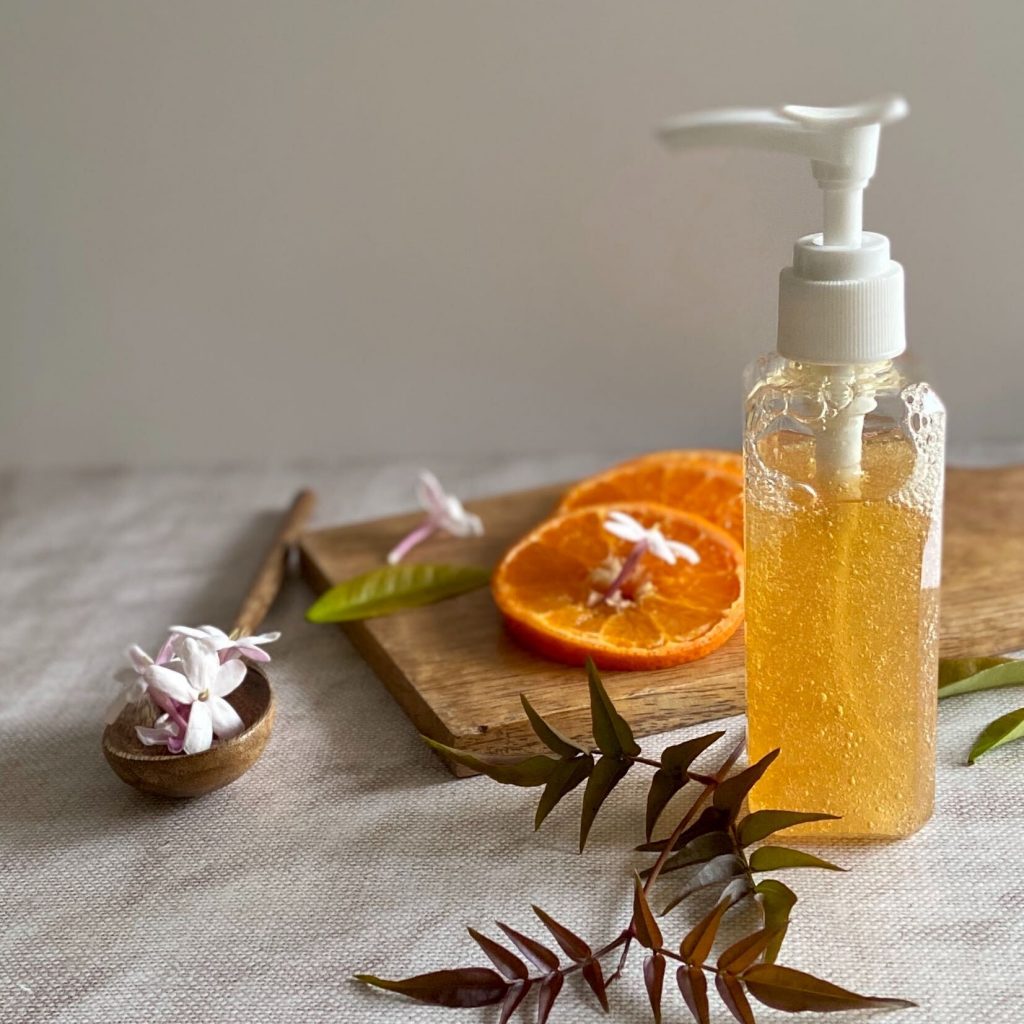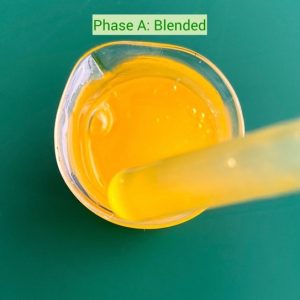In today’s blog post, we want to show you how to make a simple yet lovely, natural clarifying shampoo at home. Following on from our previous post about comparing non-ionic surfactants, we are now going to show you how these surfactants work in a formulation, as well as looking at the results you can achieve when blending them with surfactants from other groups.
Read more: Five Natural Surfactants for use in Organic Cosmetics
As you may remember, non-ionic surfactants have a neutral charge and as such will be compatible with surfactants of different charge. In this shampoo formulation will be mixing non-ionic surfactants with other types of surfactants (we’ll explain why later in this blog post!).
What Makes a Good Shampoo?
The base of any shampoo should foam well, should cleanse well and should not leave the hair dry and frizzy. Think of a shampoo formulation as a two-step formulation: a base and added extras. Within both the base and added extras you will have many choices; you can play with various surfactant blends, various gum blends and of course, different botanicals that work for your hair type. Learn how to make a natural clarifying shampoo with jasmine & mandarin by following @FormulaBotanica's sample formulation on their blog. #naturalhair #haircare Share on X
Base Formula for a Natural Clarifying Shampoo
The base formula for a clarifying shampoo should consist of water (or hydrosols), surfactants and a thickener. These ingredients will create a lovely shampoo that produces a good lather and cleanses the hair and scalp gently but effectively.
The biggest issue formulators face is getting the viscosity of a hair cleanser right. When working with sulfates, it is easier to get the viscosity right as some added salt helps to thicken sulfate-based formulations. But with the surfactants we will be using, you will need to work with a gum or a blend of gums to achieve the viscosity you’d like. Gums can be tricky to work with, they can clump, they can create a gloopy mess. We will show you in this post how to create a lovely, non-clumping shampoo every time you get set up in your formulation lab.
Using non-ionic surfactants only is completely possible in shampoo formulations but we suggest that you use a blend of surfactants from different groups to create a well-rounded product. Add anionic ones for better cleansing and amphoteric for foam stability while the non-ionic ones will help maintain the gentleness of your product.
Botanical Ingredients to add to the Base Formula
Now that we have the foaming and cleansing part clarified, let us focus on some botanicals you can add to your shampoo to personalise it and give it different properties. You will want to include some proteins, such as hydrolysed wheat or rice proteins.
Proteins are excellent conditioning agents for shampoos and conditioners. Rice protein is said to work well in shampoos designed to increase hair volume while wheat protein is used in hair strengthening shampoos. They add shine to the hair, making it more resilient.
Panthenol is a humectant that you could also include in your shampoo formulation. It moisturises the hair, makes it more manageable and shiny. You have a huge collection of botanical actives that you could include in your shampoos. Just to give you some inspiration, you could add essential oils (in small amounts), actives such as caffeine, proteins and botanical extracts such as eucalyptus, rosemary or aloe vera.
How to Make a Clarifying Shampoo at Home: Formulation
Now that you’re ready to make your own natural clarifying shampoo, gather together the following ingredients from your formulation stash (or order them from the suppliers listed at the bottom of this blog post):
| Phase | Ingredient | Grams |
| A | Coco glucoside | 10 |
| A | Red Mandarin essential oil | 0.5 |
| A | Ylang ylang essential oil | 0.2 |
| B | Sodium cocoyl glutamate | 25 |
| B | Decyl glucoside | 6 |
| B | Cocamidopropyl betaine | 5 |
| C | Jasmine hydrosol | 40.6 |
| C | Hydrolysed rice protein | 3 |
| C | Panthenol | 3 |
| D | Glycerine | 5 |
| D | Xanthan gum | 0.7 |
| E | Preservative Eco / Geogard ECT | 1 |
| E | Lactic acid | As much as needed |
How to Make a Natural Clarifying Shampoo: Step by Step
Follow our instructions step by step in order to make your own version of our Jasmine & Mandarin Clarifying Shampoo:- Blend all Phase A ingredients together in a beaker or container.
The decyl glucoside (surfactant) will help solubilise the essential oils, so no oily residue will float on top of your shampoo.
- Separately blend all the Phase B ingredients in a beaker or container.
Complete this step slowly to avoid creating too much foam when working with your surfactants.
- Separately blend all the Phase C ingredients in a beaker or container.
Add your panthenol and hydrolysed rice protein to the jasmine hydrosol.
- Finally in a separate container, blend the Phase D ingredients.
By blending the glycerine and xanthan gum, you are aiming for a smooth texture as this will prevent the gum from clumping
- Begin assembling the shampoo.
Start by combining the Phase B and Phase C ingredients together. Pour the contents of one beaker into the other and blend.
- Next add the Phase A ingredients to your overall blend.
Make sure to stir all of the ingredients together well.
- Next add the Phase D glycerine/gum slurry to your overall blend.
Stir in the gum and glycerine mixture to create a homogenous blend.
- Wait a moment.
Leave the ingredients to thicken slightly at this point.
- Check and adjust the pH.
You are aiming for the blend to reach a pH of 5.5 to 6.
- Add a preservative to your overall blend.
Add Phase E, the preservative, to your shampoo blend.
- Check and adjust the pH as necessary.
We are looking for a pH of 5 in your overall blend.
- Cover and leave for 24 hours.
Cover the beaker and leave for 24 hours for the gel consistency to form and for the gel to become clear.
- Blend the essential oils with the surfactant to solubilise the oils
- Phase A blended together
- Wait 24 hours for any haziness to clear
Formulation tips
- If you have a solubiliser such as Symbiosolv Clear Plus, you can use that in Phase A. If you do, remember to adjust the water to make the formula up to 100 grams. We used coco glucoside instead this time, but the choice is yours.
- Try to work with a xanthan gum that’s in a powder form, not the xanthan that comes in little grains. We use this type of gum because the powder is easier to work with – the little grains take a long time to swell and can create blobs.
- Using other gums can affect viscosity. Don’t be put off, experiment!
- Always leave your shampoo formula to rest overnight or 24 hours. Your blend may be hazy, but it will clear up (see photo).
Read more: How to make a Natural Shampoo with Rosemary & Mint
Shampoo Ingredient Suppliers
Below is a list of several suppliers who stock some of the ingredients used in our natural clarifying shampoo formulation. Once you enrol with Formula Botanica, you will receive our comprehensive global supplier list which contains close to 300 suppliers around the world.
UK and EU
- Coco glucoside: The Soap Kitchen
- Coco glucoside: Alexmo Cosmetics
- Decyl glucoside: The Soap Kitchen
- Decyl glucoside: Alexmo Cosmetics
- Lauryl glucoside: The Soap Kitchen
- Lauryl glucoside: Elemental EU
- Sodium cocoyl glutamate: The Soap Kitchen
- Sodium cocoyl glutamate: Alexmo Cosmetics
- Cocamidopropyl betaine: The Soap Kitchen
- Cocamidopropyl betaine: Manske
- Hydrolysed rice protein: Aroma-Zone
- Alternative: wheat protein: Aroma-Zone
- Alternative: blend: Manske
USA
- Coco glucoside: Ingredients To Die For
- Decyl glucoside: Ingredients To Die For
- Lauryl glucoside: Organic Creations
- Sodium cocoyl glutamide: Les Ames Fleurs
- Cocamidopropyl betaine: Formulator Sample Shop
- Hydrolysed rice protein: Ingredients To Die For
- Alternative: Oat Protein: Making Cosmetics
Natural Clarifying Shampoo FAQs
The overall function for a clarifying shampoo is detergency while keeping the hair untangled and shiny. This type of formulation will generally consist of a clear liquid and may be packaged in a transparent bottle.
Natural clarifying shampoos consist of water (or water-based ingredients), a primary surfactant, one or more co-surfactants, botanical extracts and fragrances, thickeners and preservatives.
Formula Botanica suggests that you use a blend of surfactants from different groups to create a well-rounded product. Add anionic surfactants for better cleansing, amphoteric surfactants for foam stability and non-ionic surfactants to help maintain the gentleness of your natural shampoo formulation.
Proteins are excellent conditioning agents for shampoos. Rice protein is said to work well in shampoos designed to increase hair volume while wheat protein is used in hair strengthening shampoos. These extracts add shine to the hair.
Always leave your shampoo formula to rest overnight or 24 hours. Your blend may be hazy, but it will clear up.
Formula Botanica teaches its award-winning online Diploma in Organic Haircare Formulation. Enrol for this online course and you will soon also be making shampoos, scalp cleansers, oleogels, leave-in conditioners, salt sprays, texturisers, de-tangler butters, mousses, gels, sculpting clays and much more.
Do you love the idea of making your own natural haircare but don’t know where to start? Or did you find this natural clarifying shampoo too advanced? Don’t worry, because we’ve got an award-winning online courses all about organic haircare formulation and we open enrolment twice a year. Pre-register now for our Diploma in Organic Haircare Formulation and you will soon also be making shampoos, scalp cleansers, oleogels, leave-in conditioners, salt sprays, texturisers, de-tangler butters, mousses, gels, sculpting clays and more.
Leave us a comment

Timi was a key member of the Formula Botanica team from 2015 to 2020; first as our Education Manager and then as Head of Formulation & Research. You can find out more about the Formula Botanica team here.





























